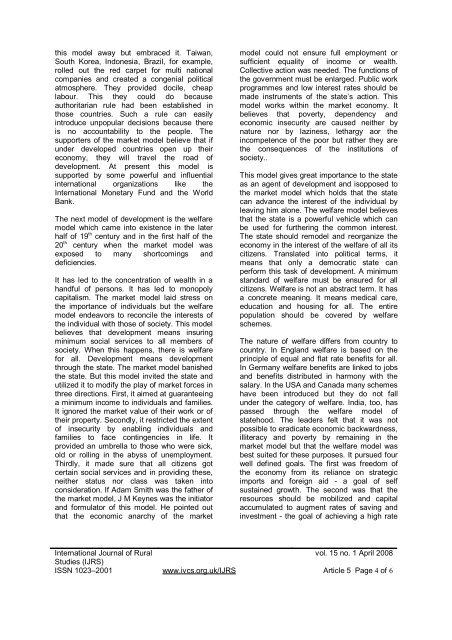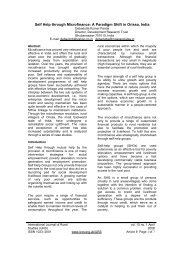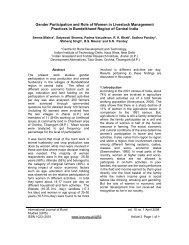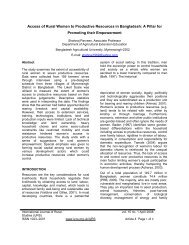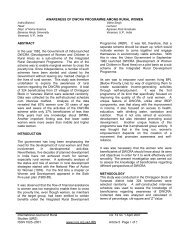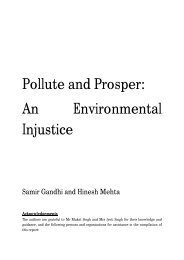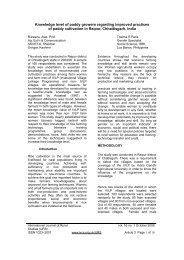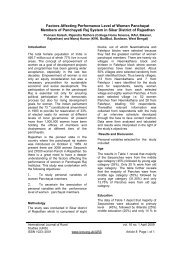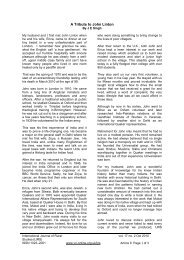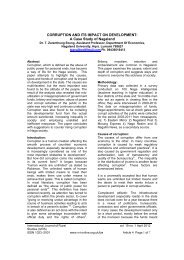5. Economics of Rural Development - Volunteers for Rural India
5. Economics of Rural Development - Volunteers for Rural India
5. Economics of Rural Development - Volunteers for Rural India
Create successful ePaper yourself
Turn your PDF publications into a flip-book with our unique Google optimized e-Paper software.
this model away but embraced it. Taiwan,South Korea, Indonesia, Brazil, <strong>for</strong> example,rolled out the red carpet <strong>for</strong> multi nationalcompanies and created a congenial politicalatmosphere. They provided docile, cheaplabour. This they could do becauseauthoritarian rule had been established inthose countries. Such a rule can easilyintroduce unpopular decisions because thereis no accountability to the people. Thesupporters <strong>of</strong> the market model believe that ifunder developed countries open up theireconomy, they will travel the road <strong>of</strong>development. At present this model issupported by some powerful and influentialinternational organizations like theInternational Monetary Fund and the WorldBank.The next model <strong>of</strong> development is the welfaremodel which came into existence in the laterhalf <strong>of</strong> 19 th century and in the first half <strong>of</strong> the20 th century when the market model wasexposed to many shortcomings anddeficiencies.It has led to the concentration <strong>of</strong> wealth in ahandful <strong>of</strong> persons. It has led to monopolycapitalism. The market model laid stress onthe importance <strong>of</strong> individuals but the welfaremodel endeavors to reconcile the interests <strong>of</strong>the individual with those <strong>of</strong> society. This modelbelieves that development means insuringminimum social services to all members <strong>of</strong>society. When this happens, there is welfare<strong>for</strong> all. <strong>Development</strong> means developmentthrough the state. The market model banishedthe state. But this model invited the state andutilized it to modify the play <strong>of</strong> market <strong>for</strong>ces inthree directions. First, it aimed at guaranteeinga minimum income to individuals and families.It ignored the market value <strong>of</strong> their work or <strong>of</strong>their property. Secondly, it restricted the extent<strong>of</strong> insecurity by enabling individuals andfamilies to face contingencies in life. Itprovided an umbrella to those who were sick,old or rolling in the abyss <strong>of</strong> unemployment.Thirdly, it made sure that all citizens gotcertain social services and in providing these,neither status nor class was taken intoconsideration. If Adam Smith was the father <strong>of</strong>the market model, J M Keynes was the initiatorand <strong>for</strong>mulator <strong>of</strong> this model. He pointed outthat the economic anarchy <strong>of</strong> the marketmodel could not ensure full employment orsufficient equality <strong>of</strong> income or wealth.Collective action was needed. The functions <strong>of</strong>the government must be enlarged. Public workprogrammes and low interest rates should bemade instruments <strong>of</strong> the state’s action. Thismodel works within the market economy. Itbelieves that poverty, dependency andeconomic insecurity are caused neither bynature nor by laziness, lethargy aor theincompetence <strong>of</strong> the poor but rather they arethe consequences <strong>of</strong> the institutions <strong>of</strong>society..This model gives great importance to the stateas an agent <strong>of</strong> development and isopposed tothe market model which holds that the statecan advance the interest <strong>of</strong> the individual byleaving him alone. The welfare model believesthat the state is a powerful vehicle which canbe used <strong>for</strong> furthering the common interest.The state should remodel and reorganize theeconomy in the interest <strong>of</strong> the welfare <strong>of</strong> all itscitizens. Translated into political terms, itmeans that only a democratic state canper<strong>for</strong>m this task <strong>of</strong> development. A minimumstandard <strong>of</strong> welfare must be ensured <strong>for</strong> allcitizens. Welfare is not an abstract term. It hasa concrete meaning. It means medical care,education and housing <strong>for</strong> all. The entirepopulation should be covered by welfareschemes.The nature <strong>of</strong> welfare differs from country tocountry. In England welfare is based on theprinciple <strong>of</strong> equal and flat rate benefits <strong>for</strong> all.In Germany welfare benefits are linked to jobsand benefits distributed in harmony with thesalary. In the USA and Canada many schemeshave been introduced but they do not fallunder the category <strong>of</strong> welfare. <strong>India</strong>, too, haspassed through the welfare model <strong>of</strong>statehood. The leaders felt that it was notpossible to eradicate economic backwardness,illiteracy and poverty by remaining in themarket model but that the welfare model wasbest suited <strong>for</strong> these purposes. It pursued fourwell defined goals. The first was freedom <strong>of</strong>the economy from its reliance on strategicimports and <strong>for</strong>eign aid - a goal <strong>of</strong> selfsustained growth. The second was that theresources should be mobilized and capitalaccumulated to augment rates <strong>of</strong> saving andinvestment - the goal <strong>of</strong> achieving a high rateInternational Journal <strong>of</strong> <strong>Rural</strong>vol. 15 no. 1 April 2008Studies (IJRS)ISSN 1023–2001 www.ivcs.org.uk/IJRS Article 5 Page 4 <strong>of</strong> 6


